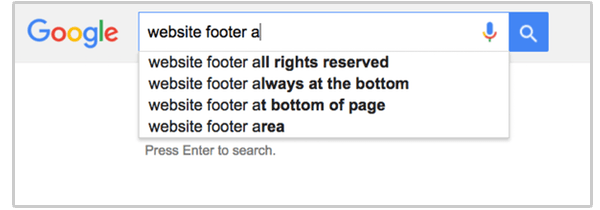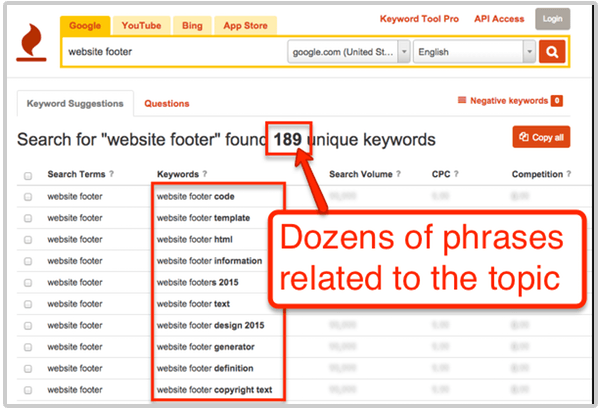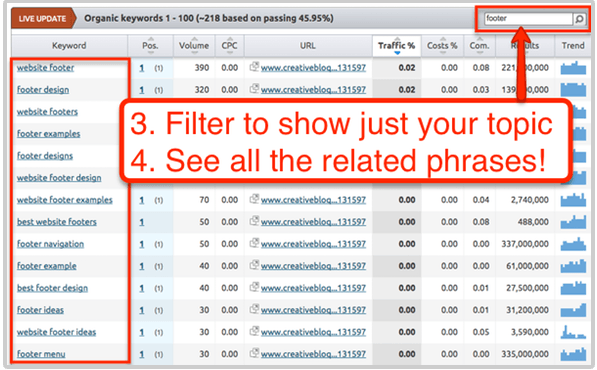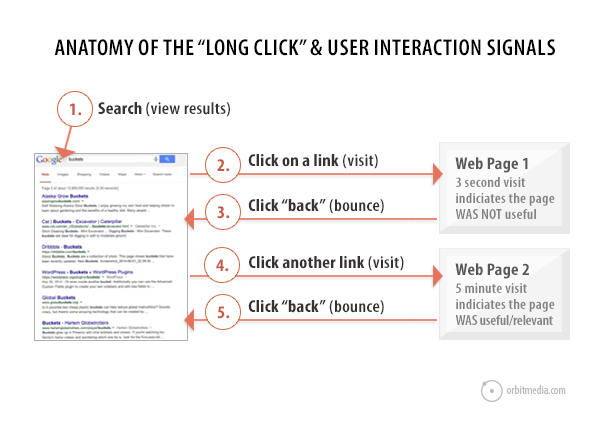Times change! Platforms evolve and Google is one of them. As the search engine changes, so does search engine optimization (SEO).
Actually, search doesn’t change much and doesn’t change fast, which is why we rarely write posts about trends. Articles we published years ago are still relevant today.
But there is a gradual evolution in trends and tactics in search. And we’ve rounded up a few of them here. These are the five most important actions you can take to make sure that your marketing aligns with where search is going.
Take these specific steps to future-proof your rankings!
1. Adapt to Semantic Search: Target Topics, Not Just Phrases
Google is officially a semantic search engine, which means it’s connecting visitors to pages with the meaning they’re looking for, not just the letters and words they typed into that little box.
To adapt to this, you need to target a broader topic, not just the specific phrase. Spread your meaning out, using related phrases, covering the things that are semantically linked.
There are several ways to find the phrases are semantically linked, deep in the heart of Google.
First, start typing your target phrase into Google. See how it begins suggesting search terms? As you slowly type in each letter, you’ll see more. Try typing more letters as if you’re starting a new word. Try entering a question word at the beginning of your phrase. You’ll soon find a wealth of words connected to your topic.
Here’s an example of how we did this research for a recent post about website footer design.

Those are phrases that are connected to your meaning. Write them down.
Shortcut! Use Keyword tool.io to find dozens of suggested phrases quickly.

Next, hit enter to search for your target keyphrase and scroll down to the bottom of the search results. See the “search related to…” links? Those are phrases that are connected to your meaning. Write them down.

Third, you can use competitive analysis. See the top ranked page for your target phrase? That page likely ranks for many related phrases. Each is semantically linked to your topic.
To find a list of all these phrases, put that top ranked site into a rank checking tool such asSEMrush (note: the free version gives you some data, the paid version gives you all of it).
Click “Positions” to see the search rankings for that domain.

Now you can filter this report to show just the phrases related to your topic. See the related phrases? Write them down.

By now, you should have a list of phrases related to your topic with strong evidence that these words are semantically linked to your topic.
For our footer design article, these were our words:
website copyright footer
website footer copyright text
website footer examples
header and footer
website footer definition
at the bottom of the page
designing a website footer
fat footer
guidelines
standards
best practices
usability
content
ideas
inspiration
links SEO
sitemap
social media
navigation
purpose of
responsive
template
Now as we write the article, we incorporate these ideas into the piece. We find ways to include these phrases in the natural flow of the writing. This indicates our relevance not just for the specific phrase, but for the broader topics.
Jayson DeMers, AudienceBloom
“As Google refines its algorithm based on the way search queries are changing (i.e., natural language queries through digital personal assistants like Siri), we’re seeing on-page keyword and content-based features grow in importance. In Moz’s 2015 Search Engine Ranking Factors report, respondents (all of whom were industry experts) rated such elements as the third-highest in importance with regard to ranking correlations, right behind domain and page-level link features. Ride the wave by ensuring your content is adapted to semantic search.”
We have now adapted to semantic search.
2. Adapt to Voice Search: Use Full, Natural Language Sentences
Every day, more of us are doing hands-off, keyboardless searches. We already use voice to ask questions in our phones (Siri and Google Now) and we’ll soon be talking to our phones and cars.
Voice-based queries tend to be longer phrases. They tend to be questions.
To adapt your content to this trend, optimize your content by using sentences that provide the complete meaning, both questions and answers.

For example, if you’re writing a post about enzyme exfoliation, rather than writing this:
One type of exfoliation uses enzymes. This approach breaks down the “glue” that holds dead skin cells together.
Write sentences that contain the complete meaning, and would stand on their own, such as:
What is enzyme exfoliation?
Enzyme exfoliation is a type of chemical exfoliation that breaks down the “glue” that holds dead, dulling skin cells together.
See how each sentence stands on its own? Write like your writing a dictionary. This aligns your content with longer, keyboardless queries.
This kind of writing can benefit you in desktop, keyboard-based searches. Ever seen an “answer box” in search results? These tend to appear when the content includes sentences that provide complete answers in complete sentences.

Answer boxes have the benefit of making the search results below somewhat irrelevant. It’s a dominant position. But they have the disadvantage of including enough content that the visitor may not need to click through to the page.
Dr. Pete Meyers, MO Z
Z
“If you see that certain searches return “featured snippets” (Google’s name for answer boxes with attribution) and if you’re ranking on page 1 for those searches, try tuning up your on-page content and title tag to better match the question. Once you clear the page-1 hurdle, Google seems to be relying mostly on how well your page matches the question.The closer you match, the better your chances. Keep in mind that some questions are implied. A search like “ethernet” may return a featured snippet, because Google is seeing it as implying “What is ethernet?”. So, match to what Google thinks the question is.”
We have now adapted our writing to voice-based search.
3. Adapt to Future Link Spam Penalties: Build Your Network of Content Creators
To call it “link building” is politically incorrect. I understand why. It feels spammy. But links and mentions from authority sites do matter. They are perhaps the most important search ranking factor.
As the last artificial link building tricks are discovered and the few remaining link spam tactics are penalized, there is one sure way to dodge future changes and potential penalties: focus on relationships, not links.
If you trace back the process from lead to traffic, traffic to ranking, and ranking to links, you’ll find it starts with people.

These days, those relationships typically start on social media. If you understand how social media affects search engine rankings, you know that there are specific actions that lead to your desired outcomes.
- Find content creators using social media search tools.
- Subscribe to their content, follow, listen and learn.
- Interact with them within their content, through comments and shares.
- Connect on social networks, reach out and move the conversation offline.
- Invite them into your content through collaboration, quotes, roundups and email interviews.
- Take it offline, on the phone, Skype, G+ Hangouts or in person.
It’s about making friends! Building an active network of bloggers will do wonders for your future search efforts. This can not be overstated.
 Andrea Vahl, Social Media Coach, Speaker & Strategist
Andrea Vahl, Social Media Coach, Speaker & Strategist
“Creating relationships with other people in my industry has been so beneficial to getting more links – from the opportunity to guest post to the awareness around each other’s content.”
Need help? Take a look at our online networking guide, which lists 35 steps for connecting with anyone.
We have now adapted to changes for off-site factors such as link spam penalties.
Conversion Conference has evolved into Digital Growth Unleashed!
Create the most compelling end-to-end customer experiences. Attract, persuade, serve, and the technology to make it happen – we’ve got you covered with four parallel breakout tracks! Plan early and get the absolute lowest rates possible for May 16-17, 2018 at the Mandalay Bay Casino & Resort, Las Vegas.
4. Adapt to User Interaction Signals: Use Formatting and Media that Keeps Visitors Longer
Quality affects rankings, right? Better articles rank higher. But how does Google know what’s good? The answer is in your Analytics.
Visitors who come to your page from a search engine sometimes leave without visiting another page. This is called a “bounce.” There are two kind of bounces:
- The visitor hated the page and hit the back button after 10 seconds.
- The visitor loved the page, read every word, stayed for 10 minutes and then finally left
So a “bounce” doesn’t correlate with high or low quality. But the time on page does.

The first example is a “short click” and the second is a “long click.” The difference is the dwell time. Dwell time is the average time on page for visitors from search engines. Search engines see this and use it as a search ranking factor. It’s a powerful indicator of quality and relevance.
You may be able to see the correlation between rankings and time on page in your own Analytics. Look at the Behavior > Site Content > All Pages report. Set it to comparison view with Avg Time on Page as the dimension. There’s your correlation!

So the next question is how do you get visitors to stay? The best answer is to make it a great page (see #5 below) but there are other, more specific tactics:
- Add a relevant featured image
Pay attention to blog image best practices. A good image pulls the visitor in. - Add multiple images
If the visitors scans down and finds a long desert of text, they are more likely to leave. Make an image visible at every scroll depth! - Break up long paragraphs
A sure way to lose a visitor is to hit them with a wall of text. Keep paragraphs down to a maximum of three lines. Four tops. - Add a video
Embed a video at the top of the page. Use a custom thumbnail with a face and a headline to maximize the percentage of people who watch it. Short videos mean longer visits.
That explains the correlation between video, formatting, images and rankings. Now you know how quality directly impacts rankings.
We have adapted our content for future changes to the importance of user interaction signals in search algorithms.
Speaking of quality…
5. Adapt to All Future Changes! Make the Best Page on the Internet for the Topic
Here’s some advice you hear far too little on SEO posts. But it’s the single most important piece of advice I can give. Here goes:
Make the best piece of content on the internet for your topic
If you have actually made a page that provides the best answer to the question or offers the most detailed set of instructions, then the search engines are working very hard to help you …There are thousands of math PhDs on your side, doing their best to send visitors your way!
If you have not made a great page, then you’re just trying to trick a robot. You’re using links and keywords to win something you don’t deserve …There are thousands of computer scientists fighting against you, trying to keep you out of search results.
Make the best page on the web for your topic and you’ve future-proofed your content for all future SEO changes.
This article first appeared on the Orbit Media Blog.
About the Author
 As Strategic Director for Chicago-based Orbit Media, Andy Crestodina has provided web strategy advice to more than 1000 businesses over the last 12 years. Andy loves to teach web marketing, both as a public speaker and on the Orbit blog. He has written more than 170 articles on content marketing topics including SEO, email marketing, social media, and analytics. He is the author of “Content Chemistry: The Illustrated Handbook for Content Marketing”. Andy graduated from the University of Iowa with a degree in Asian Language and Literature and a certificate to teach Chinese.
As Strategic Director for Chicago-based Orbit Media, Andy Crestodina has provided web strategy advice to more than 1000 businesses over the last 12 years. Andy loves to teach web marketing, both as a public speaker and on the Orbit blog. He has written more than 170 articles on content marketing topics including SEO, email marketing, social media, and analytics. He is the author of “Content Chemistry: The Illustrated Handbook for Content Marketing”. Andy graduated from the University of Iowa with a degree in Asian Language and Literature and a certificate to teach Chinese.
Andy is a top-rated presenter at national conferences, focused on making each event as practical as possible by teaching immediately applicable techniques.

 717 798 3495
717 798 3495



